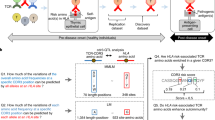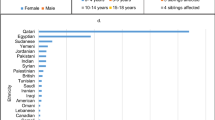Abstract
THE human leukocyte antigens (HLA) are implicated in the genetic susceptibility to a large number of diseases. Some of the diseases associated with HLA class II are related to specific amino acids or epitopes of the domain of the HLA class II molecule that is distal to the membrane1-3. In man, selective immunoglobulin A deficiency is the most common immunodeficiency, frequently resulting in recurrent sino-pulmonary infections and gastrointestinal disorders. Associations have been described with HLA class I, and to a lesser extent with different class II alleles4-9, which might indicate that they share some common feature. Here we study 95 IgA-D patients and find positive associations with three DR–DQ haplotypes and a strong negative association with a fourth haplotype. Comparison of the sequences of the polymorphic amino-terminal domain of the DQβ chain showed that the three 'susceptibility' haplotypes all had a neutral alanine or valine at position 57. The 'protective' allele had the negatively charged aspartic acid at this position (Asp 57). Codon 57 of the HLA-DQβ chain has been implicated in the susceptibility to insulin-dependent diabetes mellitus1,2. Our data suggest that the same amino acid position could possibly also influence susceptibility and resistance to selective immunoglobulin A deficiency.
This is a preview of subscription content, access via your institution
Access options
Subscribe to this journal
Receive 51 print issues and online access
$199.00 per year
only $3.90 per issue
Buy this article
- Purchase on Springer Link
- Instant access to full article PDF
Prices may be subject to local taxes which are calculated during checkout
Similar content being viewed by others
References
Todd, J. A., Bell, J. I. & McDevitt, H. O. Nature 329, 599–604 (1987).
Horn, G. T., Bugawan, T. L., Long, C. M. & Erlich, H. A. Proc. natn. Acad. Sci. U.S.A. 85, 6012–6016 (1988).
Scharf, S. J. et al. Proc. natn. Acad. Sci. U.S.A. 85, 3504–3508 (1988).
Ambrus, M., Hernádi, E. & Bajtai, G. Clin. Immun. Immunopath. 7, 311–314 (1977).
Hammarström, L. & Smith, C. I. E. Tissue Antigens 21, 75–79 (1983).
Cobain, T. J., French, M. A. H., Christiansen, F. T. & Dawkins, R. L. Tissue Antigens 22, 151–154 (1983).
Hammarström, L. et al. Tissue Antigens 24, 35–39 (1984).
Klemola, T., Savilahti, E., Koskimies, S. & Pelkonen, P. Tissue Antigens 32, 218–223 (1988).
Cuccia-Belvedera, M. et al. Tissue Antigens 34, 127–132 (1987).
Hyldig-Nielsen, J. J. et al. Proc. natn. Acad. Sci. U.S.A. 84, 1644–1648 (1987).
Schaffer, F. M. et al. Proc. natn. Acad. Sci. U.S.A. 86, 8015–8019 (1989).
Morel, P. A., Dorman, J. S., Todd, J. A., McDevitt, H. O. & Trucco, M. Proc. natn. Acad. Sci. U.S.A. 85, 8111–8115 (1988).
Ronningen, K. S., Iwe, T., Halstensen, T. S., Spurkland, A. & Thorsby, E. Hum. Immun. 26, 215–225 (1989).
Smith, W. I., Rabin, B. S., Huellmantel, A., Van Thiel, D. H. & Drash, A. Diabetes 27, 1092–1097 (1978).
Sheehy, M. J. et al. J. clin. Invest. 83, 830–835 (1989).
Todd, J. A. et al. Nature 338, 587–589 (1989).
Todd, J. A. Immun. Today 11, 122–129 (1990).
Boss, J. M. & Strominger, J. L. Proc. natn. Acad. Sci. U.S.A. 81, 1599–1603 (1984).
Lee, B. S. M., Rust, N. A., McMichael, A. J. & McDevitt, H. O. Proc. natn. Acad. Sci. U.S.A. 84, 4591–4595 (1987).
Tonnelle, C., DeMars, R. & Longe, E. O. EMBO J. 4, 2839–2847 (1985).
Dupont, B. (ed.) in Immunobiology of HLA Vol. 1 1027–1031 (Springer, New York, 1989).
Olerup, O. et al. Proc. natn. Acad. Sci. U.S.A. 86, 7113–7117 (1989).
Carlsson, B., Wallin, J., Böhme, J. & Möller, E. Hum. Immun. 20, 95–113 (1987).
Bidwell, J. L., Bidwell, E. A., Laundy, G. J., Klouda, P. T. & Bradley, B. A. Molec. Immun. 24, 513–522 (1987).
Bidwell, J. L. Immun. Today 9, 18–23 (1988).
Lee, B. S. M., Bell, J. I., Rust, N. A. & McDevitt, H. O. Immunogenetics 26, 85–91 (1987).
Author information
Authors and Affiliations
Rights and permissions
About this article
Cite this article
Olerup, O., Edvard Smith, C. & Hammarström, L. Different amino acids at position 57 of the HLA-DQβ chain associated with susceptibility and resistance to IgA deficiency. Nature 347, 289–290 (1990). https://doi.org/10.1038/347289a0
Received:
Accepted:
Issue Date:
DOI: https://doi.org/10.1038/347289a0
This article is cited by
-
Prevalence of selective immunoglobulin A deficiency in Greek children and adolescents with type 1 diabetes
World Journal of Pediatrics (2016)
-
Common Variable Immunodeficiency
The Indian Journal of Pediatrics (2016)
-
The higher frequency of IgA deficiency among Swedish twins is not explained by HLA haplotypes
Genes & Immunity (2015)
-
Caucasian Origin of Disease Associated HLA Haplotypes in Chinese Blood Donors with IgA Deficiency
Journal of Clinical Immunology (2014)
-
IgA Deficiency and the MHC: Assessment of Relative Risk and Microheterogeneity Within the HLA A1 B8, DR3 (8.1) Haplotype
Journal of Clinical Immunology (2010)
Comments
By submitting a comment you agree to abide by our Terms and Community Guidelines. If you find something abusive or that does not comply with our terms or guidelines please flag it as inappropriate.



